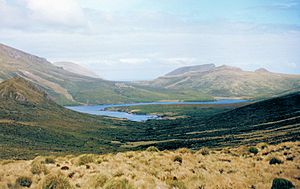Campbell Island sheep facts for kids
The Campbell Island sheep were a special type of domestic sheep that used to live wild on Campbell Island. This island is part of New Zealand and is located far south in the ocean. These sheep were once farm animals, but they became feral, meaning they lived in the wild without human care.
Contents
History of the Campbell Island Sheep
How Sheep Arrived on Campbell Island
Sheep were first brought to Campbell Island in the late 1890s. This happened after the island became part of New Zealand's farming system in 1896. This system allowed people to rent land for farming, which was called a pastoral lease.
The first person to rent the island was James Gordon. In 1896, he sent 400 sheep to the island. He also sent wood to build shelters for them.
Early Farmers and More Sheep
After some money problems, Captain Tucker bought the lease in 1900. He brought even more sheep to the island. He sent at least three groups of about 1,000 sheep each. Most of these were Merino sheep or a mix with Merino.
Later, in 1916, two business people from Otago, J. Mathewson and D. Murray, took over the lease. They created the Campbell Island Company. This company hired shepherds and shearers to work on the island for a year at a time.
The Farm is Abandoned
In 1927, John Warren, a farmer, bought the lease. He brought another 5,000 sheep to the island. However, the prices for wool and meat dropped a lot in 1929.
Two years later, in 1931, John Warren and his workers had to leave the island. They were very poor and left the farm and all the sheep behind. The island's lease was officially ended in 1934. In 1937, the island was set aside to protect its plants and animals. It officially became a nature reserve in 1954.
The Sheep Population Changes
When the sheep first arrived, there was plenty of food for them. Their numbers grew quickly. Around 1913, there were about 7,000 to 8,000 sheep on the island.
Over time, the sheep ate many of the tasty plants. This caused their population to go down. By 1931, when the farm was abandoned, there were only about 4,000 sheep left. In 1958, a count showed only about 1,000 sheep remained.
Removing the Sheep
Later, the sheep numbers started to grow again a bit. In 1970, a fence was built across the island. All 1,300 sheep on the northern side of the fence were removed. A similar number on the southern side were left for a while.
By the late 1980s, all the remaining sheep were removed from the island. However, before this, in 1975 and 1976, ten live sheep were taken from the island. These sheep were brought to New Zealand to be bred in captivity. Their descendants were kept as a pure group until 2005.


